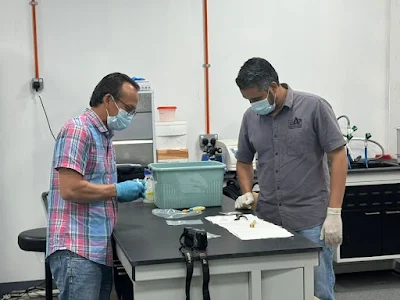New advancements in the study of the ‘Penang Woman,’ a prehistoric human female whose remains were discovered at the Guar Kepah archaeological site, continue to captivate scientists and historians worldwide. The remains, initially discovered in 2017, are now the focus of DNA analysis and radiocarbon dating using Accelerator Mass Spectrometry (AMS) to provide fresh insights into early human life in Southeast Asia and possibly rewrite history.
"The DNA analysis of the ‘Penang Woman’ is a groundbreaking development," said Professor Dr Stephen Chia, Director of Universiti Sains Malaysia's (USM) Centre for Global Archaeological Research (CGAR). “The primary objective of this collaboration is to uncover the genetics and chronometric age of the ‘Penang Woman’ through these advanced methods.”
Earlier, the ‘Penang Woman’ had been estimated to be around 5,700 years old based on the shell sample obtained next to the skeletal remains. However, Dr Chia questioned the accuracy of the initial carbon dating methods and noted that direct dating using AMS, similar to methods used in the US, is more precise. Dr Chia also mentioned that based on her skull, the ‘Penang Woman’ seemed to possess Mongoloid features.
Dr Chia highlighted that the earthenware pottery found at the Guar Kepah site is possibly dated to around 4,000 years old. However, it cannot be determined whether the pottery and the ‘Penang Woman’ were from the same period. Incidentally, the ‘Penang Woman’ was found in a flexed position, rather than in an extended position, where the body is laid on its back—flat, straight and extended.
“The Paleolithic hunter-gatherers usually bury their dead in a flexed position, unlike the Neolithic communities that bury their dead in an extended position,” said Dr Chia. He also suspected that the ‘Penang Woman’ might be from the Epipaleolithic period (sometimes known as Hoabinhian).
Previously, a total of 41 skeletons from three shell middens identified as ‘A’, ‘B’, and ‘C’ in Guar Kepah were excavated by British archaeologists between 1865 and 1934. These skeletons are now at the National Natuurhistorisch Museum in Leiden, Holland.
The ‘Penang Woman’ was accidentally found in what was known as ‘shell midden C,’ during the construction of the Guar Kepah Gallery. “The bones below the pelvic area had been partially destroyed by the backhoe excavating the area. Before the discovery of the ‘Penang Woman,’ the site had already been badly damaged due to disturbances. The skeletal remains were found underneath a house, about one meter deep,” said Dr Chia.
In Malaysia, the Neolithic period spans from 4,500 to 2,000 years ago, while the Late Paleolithic or Epi-Paleolithic period ranges from 10,000 to 6,000 years ago.
The
remains of the ‘Penang Woman’ are currently kept in a humidity-controlled
cabinet at the USM. “This is the only scientific laboratory for archaeological
and geochemical research
in Southeast Asia. The air-conditioning runs for 24
hours at between 18-20 degrees Celsius.

“We need to keep the bones in a Relative Humidity of between 50% to 60% to ensure that the bones do not deteriorate and turn to dust,” said Dr Chia, adding that the facility was specially built to preserve and conserve bone specimens.
Dr Suresh Narayanen, who is part of the research team, briefed this writer on their research. Bone sampling for DNA analysis began in April 2024, with experts from the School of Health Science USM and Malaysian Genomics Resource Centre Berhad (MGRC) conducting detailed cleaning and checking of the Guar Kepah skeleton. “Selected bones, such as the forearm and rib bones, have been treated with sodium hypochlorite and drilled with minimal destruction to their morphological structures. A tooth sample has been selected for AMS radiocarbon dating,” said Dr Suresh.
Assoc. Prof Dr Edinur Hisham Atan, a geneticist with USM’s School of Health Sciences added that approximately 250 to 750 nanograms of bone powder were collected from each bone and transferred to 2.5ml microcentrifuge tubes for further analysis at MGRC. These samples will be used to recover genetic information of the ‘Penang Woman’.
“We will use cutting-edge methods for DNA extraction and sequencing.
“The ‘Penang Woman’ genome will provide an important reference source for re-constructing genetic history in Malaysia and create a new dimension for archaeogenetics research of radiocarbon-dated ancient human remains in the country,” he said.
Studies on the earthenware pottery of Guar Kepah are being conducted at USM. “Two samples have been submitted for Optically Stimulated Luminescence (OSL) dating, while others are examined using multiple analytical techniques to determine their source, technology, and origin”, said Dr Suresh.
Experts from USM and the MGRC are collaborating to explore the ‘Penang Woman’s’ roots. An agreement signed on 13 March establishes a framework for comprehensive scientific studies.
“The research collaboration between researchers and specialists from MGRC and USM will result in a high-impact archaeogenetic study to produce new scientific and historical narratives on the ancient technology and culture embraced by the Guar Kepah community,” said Dr Suresh.
To preserve and showcase these invaluable findings, the Guar Kepah Archaeological Site is being transformed into a state-of-the-art museum. This museum will serve as an educational hub, providing the public with access to the rich prehistoric heritage of Penang. “A replica of the ‘Penang Woman’ will be transferred to the museum once it is completed, allowing visitors to view this significant piece of history firsthand,” said Dr Chia.
* This article was published in TheSun on 18 July 2024.




